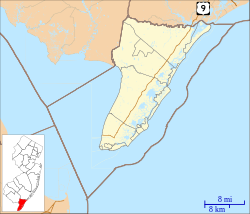10th Street | |||||||||||
|---|---|---|---|---|---|---|---|---|---|---|---|
 Ocean City Tenth Street Station in 2010 | |||||||||||
| General information | |||||||||||
| Location | 10th Street and Haven Avenue, Ocean City, New Jersey | ||||||||||
| Coordinates | 39°16′44″N74°34′43″W / 39.27889°N 74.57861°W | ||||||||||
| Bus routes | 3 | ||||||||||
| Bus operators | |||||||||||
| Construction | |||||||||||
| Accessible | yes | ||||||||||
| History | |||||||||||
| Closed | August 13, 1981 [1] | ||||||||||
| Former services | |||||||||||
| |||||||||||
Ocean City Tenth Street Station | |||||||||||
| Area | 0.5 acres (0.20 ha) | ||||||||||
| Built | 1898 | ||||||||||
| Architect | William Hunter | ||||||||||
| Architectural style | Shingle Style | ||||||||||
| MPS | Operating Passenger Railroad Stations TR | ||||||||||
| NRHP reference No. | 84002610 [2] | ||||||||||
| NJRHP No. | 1010 [3] | ||||||||||
| Significant dates | |||||||||||
| Added to NRHP | June 22, 1984 | ||||||||||
| Designated NJRHP | March 17, 1984 | ||||||||||
| |||||||||||
Ocean City Tenth Street Station is located in Ocean City in Cape May County, New Jersey. Built in 1898, it served rail service until 1981. The building now operates as the Ocean City Transportation Center, which is a bus stop for NJ Transit.
Contents
In 2012, the building was damaged after being flooded by Hurricane Sandy, and was reconstructed to its historic appearance.




